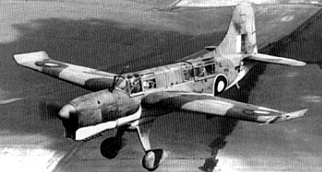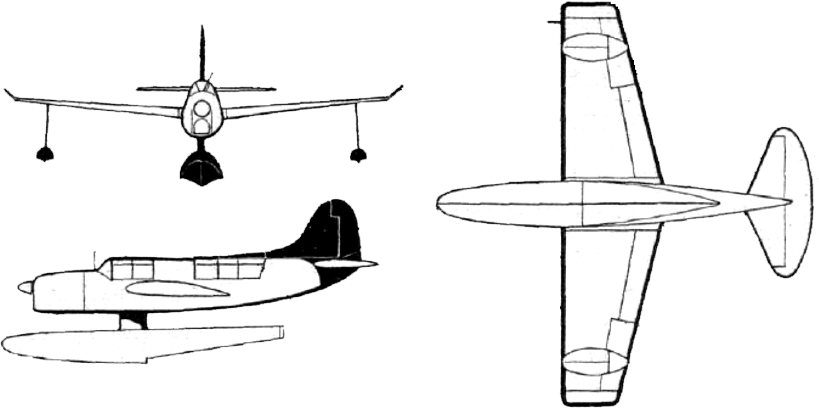Curtiss SO3C Seamew on:
[Wikipedia]
[Google]
[Amazon]
The Curtiss SO3C Seamew was developed by the
 From the time it entered service the SO3C suffered two serious flaws: inflight stability problems and problems with the unique Ranger air-cooled, inverted V-shaped inline engine. The stability problem was mostly resolved with the introduction of upturned wingtips and a larger rear tail surface that extended over the rear observer's cockpit. The additional tail surface was attached to the rear observer's sliding canopy and pilots claimed there were still stability problems when the canopy was open; the canopy was often open because the aircraft's main role was spotting. While the in-flight stability problem was eventually addressed (although not fully solved), the Ranger XV-770 engine proved a dismal failure even after many attempted modifications. Poor flight performance and a poor maintenance record led to the SO3C being withdrawn from US Navy first line units by 1944. The older biplane SOC was taken from stateside training units and restored to first-line service on many US Navy warships until the end of World War II.
From the time it entered service the SO3C suffered two serious flaws: inflight stability problems and problems with the unique Ranger air-cooled, inverted V-shaped inline engine. The stability problem was mostly resolved with the introduction of upturned wingtips and a larger rear tail surface that extended over the rear observer's cockpit. The additional tail surface was attached to the rear observer's sliding canopy and pilots claimed there were still stability problems when the canopy was open; the canopy was often open because the aircraft's main role was spotting. While the in-flight stability problem was eventually addressed (although not fully solved), the Ranger XV-770 engine proved a dismal failure even after many attempted modifications. Poor flight performance and a poor maintenance record led to the SO3C being withdrawn from US Navy first line units by 1944. The older biplane SOC was taken from stateside training units and restored to first-line service on many US Navy warships until the end of World War II.
 A number of the SO3C-1s, a fixed undercarriage version, were ordered by the
A number of the SO3C-1s, a fixed undercarriage version, were ordered by the

 ;
*
;
*
35720248
* * Swanborough, Gordon and Peter M. Bowers. ''United States Navy Aircraft since 1911''. London: Putnam & Company Ltd., Second edition, 1976. . *
SLING SHOT PLANES
May 1943 Popular Science article {{DEFAULTSORT:Curtiss So3c Seamew SO3C Floatplanes Single-engined tractor aircraft Mid-wing aircraft Aircraft first flown in 1939 1940s United States military reconnaissance aircraft Aircraft with fixed conventional landing gear
Curtiss-Wright Corporation
The Curtiss-Wright Corporation is an American manufacturer and services provider headquartered in Davidson, North Carolina, with factories and operations in and outside the United States. Created in 1929 from the consolidation of Curtiss, Wrigh ...
as a replacement for the SOC Seagull as the United States Navy
The United States Navy (USN) is the naval warfare, maritime military branch, service branch of the United States Department of Defense. It is the world's most powerful navy with the largest Displacement (ship), displacement, at 4.5 millio ...
's standard floatplane scout. Curtiss named the SO3C the ''Seamew'' but in 1941 the US Navy began calling it by the name ''Seagull'', the same name as the aircraft it replaced (the Curtiss SOC a biplane type), causing some confusion. The British Royal Navy kept the Curtiss name, ''Seamew'', for the SO3Cs that they ordered. One of the US Navy's main design requirements was that the SOC Seagull's replacement had to be able to operate both from ocean vessels with a single center float and from land bases with the float replaced by a wheeled landing gear.
Design and development
 From the time it entered service the SO3C suffered two serious flaws: inflight stability problems and problems with the unique Ranger air-cooled, inverted V-shaped inline engine. The stability problem was mostly resolved with the introduction of upturned wingtips and a larger rear tail surface that extended over the rear observer's cockpit. The additional tail surface was attached to the rear observer's sliding canopy and pilots claimed there were still stability problems when the canopy was open; the canopy was often open because the aircraft's main role was spotting. While the in-flight stability problem was eventually addressed (although not fully solved), the Ranger XV-770 engine proved a dismal failure even after many attempted modifications. Poor flight performance and a poor maintenance record led to the SO3C being withdrawn from US Navy first line units by 1944. The older biplane SOC was taken from stateside training units and restored to first-line service on many US Navy warships until the end of World War II.
From the time it entered service the SO3C suffered two serious flaws: inflight stability problems and problems with the unique Ranger air-cooled, inverted V-shaped inline engine. The stability problem was mostly resolved with the introduction of upturned wingtips and a larger rear tail surface that extended over the rear observer's cockpit. The additional tail surface was attached to the rear observer's sliding canopy and pilots claimed there were still stability problems when the canopy was open; the canopy was often open because the aircraft's main role was spotting. While the in-flight stability problem was eventually addressed (although not fully solved), the Ranger XV-770 engine proved a dismal failure even after many attempted modifications. Poor flight performance and a poor maintenance record led to the SO3C being withdrawn from US Navy first line units by 1944. The older biplane SOC was taken from stateside training units and restored to first-line service on many US Navy warships until the end of World War II.
Operational history
Royal Navy service
 A number of the SO3C-1s, a fixed undercarriage version, were ordered by the
A number of the SO3C-1s, a fixed undercarriage version, were ordered by the Royal Navy
The Royal Navy (RN) is the naval warfare force of the United Kingdom. It is a component of His Majesty's Naval Service, and its officers hold their commissions from the King of the United Kingdom, King. Although warships were used by Kingdom ...
Fleet Air Arm
The Fleet Air Arm (FAA) is the naval aviation component of the United Kingdom's Royal Navy (RN). The FAA is one of five :Fighting Arms of the Royal Navy, RN fighting arms. it is a primarily helicopter force, though also operating the Lockhee ...
under the terms of Lend-Lease
Lend-Lease, formally the Lend-Lease Act and introduced as An Act to Promote the Defense of the United States (),3,000 Hurricanes and >4,000 other aircraft)
* 28 naval vessels:
** 1 Battleship. (HMS Royal Sovereign (05), HMS Royal Sovereign)
* ...
. In RN service the SO3C was given the designation "Seamew", a name used again in the 1950s for the Short Seamew. Crews gave it the name "Sea Cow".
Lettice Curtis, in her book ''Forgotten Pilots'', stated "that although its standard fuel tanks held 300 gallons, it would only just take off with the eighty gallons" fixed as the maximum for Air Transport Auxiliary
The Air Transport Auxiliary (ATA) was a British civilian organisation set up at the start of the Second World War with headquarters at White Waltham Airfield in Berkshire. The ATA ferried new, repaired and damaged military aircraft between fac ...
trips. In addition the tail needed to be raised before becoming airborne, as "it was possible to take off in an attitude from which it was both impossible to recover and in which there was no aileron control." The final comment from this experienced pilot was "it is hard to imagine how, even in wartime, such an aircraft could have been accepted from the factory, let alone given valuable cargo space across the Atlantic."
The first batch for the RN was to have a centreline bomb rack and arrestor gear. Later versions, known as the Seamew Mk.I, were the SO3-2C variant. 250 Seamews were allocated and some 100 actually delivered, the last batch was refused in favour of additional Vought Kingfishers. Deliveries to the RN started in January 1944. It was declared obsolete in September the same year and completely removed from service in 1945.
The SO3C-1K was to have been taken into service as the Queen Seamew, but an order of 30 was canceled.
Seamews served with No. 744 NAS and No. 745 NAS at RCAF Yarmouth, Nova Scotia
Nova Scotia is a Provinces and territories of Canada, province of Canada, located on its east coast. It is one of the three Maritime Canada, Maritime provinces and Population of Canada by province and territory, most populous province in Atlan ...
, Canada, and with No. 755 NAS based in Hampshire
Hampshire (, ; abbreviated to Hants.) is a Ceremonial counties of England, ceremonial county in South East England. It is bordered by Berkshire to the north, Surrey and West Sussex to the east, the Isle of Wight across the Solent to the south, ...
, UK.
Variants
;XSO3C-1 :Prototype, one built originally as a landplane and later modified as a floatplane. ;SO3C-1 :Production variant, 141 built. ;SO3C-1K :SO3C-1 aircraft modified as target drones, some to the Royal Navy as the Queen Seamew I. ;SO3C-2 :Similar to SO3C-1 but with arrester gear, landplane variant could be fitted with a ventral bomb rack, 200 built. ;SO3C-2C :Lend-lease variant of the SO3C-2 with improved radio and 24V electrical system, for theRoyal Navy
The Royal Navy (RN) is the naval warfare force of the United Kingdom. It is a component of His Majesty's Naval Service, and its officers hold their commissions from the King of the United Kingdom, King. Although warships were used by Kingdom ...
as the Seamew I, 259 ordered but only about 59 were built.
;SO3C-3
:Reduced weight variant with detailed improvements and catapult operation ability removed, 39 built with a further 659 cancelled.
;SO3C-4
:Proposed variant of the SO3C-3 with arrester hook and catapult capable, not built.
;SO3C-4B
:Lend-lease variant of the SO3C-4 for the Royal Navy as the Seamew II, not built.
Operators

Royal Navy
The Royal Navy (RN) is the naval warfare force of the United Kingdom. It is a component of His Majesty's Naval Service, and its officers hold their commissions from the King of the United Kingdom, King. Although warships were used by Kingdom ...
, Fleet Air Arm
The Fleet Air Arm (FAA) is the naval aviation component of the United Kingdom's Royal Navy (RN). The FAA is one of five :Fighting Arms of the Royal Navy, RN fighting arms. it is a primarily helicopter force, though also operating the Lockhee ...
** 744 Naval Air Squadron
** 745 Naval Air Squadron
** 755 Naval Air Squadron
;
* United States Navy
The United States Navy (USN) is the naval warfare, maritime military branch, service branch of the United States Department of Defense. It is the world's most powerful navy with the largest Displacement (ship), displacement, at 4.5 millio ...
Specifications (SO3C-2)
See also
References
;Notes ;Bibliography * Bowers, Peter M. ''Curtis Aircraft, 1907–1947''. London: Putnam & Company Ltd., 1979. . * * * * Ginter, Steve. ''The Reluctant Dragon – The Curtiss SO3C Seagull/Seamew (Naval Fighters No.47)''. Simi Valley, CA: Ginter Books, 1999. . * Green, William. ''War Planes of the Second World War, Volume Six: Floatplanes''. London: Macdonald & Co. (Publishers) Ltd., 1962. * Larkins, William T. ''Battleship and Cruiser Aircraft of the United States Navy''. Atglen, PA: Schiffer Books, Inc., 1996. . OCL35720248
* * Swanborough, Gordon and Peter M. Bowers. ''United States Navy Aircraft since 1911''. London: Putnam & Company Ltd., Second edition, 1976. . *
External links
SLING SHOT PLANES
May 1943 Popular Science article {{DEFAULTSORT:Curtiss So3c Seamew SO3C Floatplanes Single-engined tractor aircraft Mid-wing aircraft Aircraft first flown in 1939 1940s United States military reconnaissance aircraft Aircraft with fixed conventional landing gear